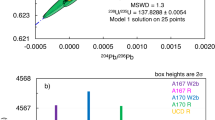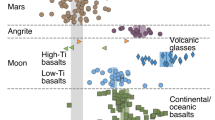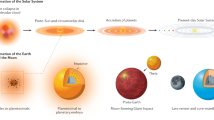Abstract
There is evidence for the early melting of the Moon1,2, and Runcorn2–4 has concluded from palaeomagnetic data that a fluid core dynamo must have been present for ∼109 yr and that the decay of a siderophile superheavy element (SHE) with a half life of ∼108 yr may have been responsible for these phenomena3–5 Libby and co-workers6 have suggested that SHE-decay could have produced certain trace-element abundance patterns in iron meteorites. Several searches7–9 have failed to detect evidence for SHE decay in iron meteorites. We describe here a search for SHE in metal fragments within ordinary chondrites. The absence of excesses of tracks along the boundaries between olivines and metal grains allows upper limits to the SHE content of the metal of ∼2.5×10−13 to ∼2.5×10−15 kg per kg to be set at a time ∼4×109 yr ago, determined from the 244Pu fission track densities in chondritic phosphates.
This is a preview of subscription content, access via your institution
Access options
Subscribe to this journal
Receive 51 print issues and online access
$199.00 per year
only $3.90 per issue
Buy this article
- Purchase on Springer Link
- Instant access to full article PDF
Prices may be subject to local taxes which are calculated during checkout
Similar content being viewed by others
References
Taylor, S. R. Lunar Science: A Post Apollo View (Pergamon, New York, 1975).
Runcorn, S. K. Proc. 8th lunar Sci. Conf., 463–469 (1977).
Runcorn, S. K. Science 199, 771–773 (1978).
Runcorn, S. K. Earth planet. Sci. Lett. 39, 193–198 (1978).
Runcorn, S. K., Libby, L. M. & Libby, W. F. Nature 270, 678–681 (1977).
Libby, W. L., Libby, W. F. & Runcorn, S. K. Nature 278, 613–617 (1979).
Bull, R. K. Nature 282, 393–394 (1979).
Nozette, S. & Boynton, W. V. Meteoritics 15, 501 (1979).
Kaiser, T., Piepgras, D. & Wasserburg, G. J. Earth planet. Sci. Lett. 52, 239–250 (1981).
Krishnaswami, S., Lal, D., Prabhu, N. & Tamhane, A. S. Science 174, 287–291 (1971).
Fleischer, R. L., Price, P. B. & Walker, R. M. Nuclear Tracks in Solids (University of California Press, Berkeley, 1975).
Wasserburg, G. J., Huneke, J. C. & Burnett, D. S. J. geophys. Res. 74, 4221–4322 (1969).
Kirsten, T., Jordan, J., Richter, H., Pellas, P. & Storzer, D. Meteoritics 12, 279–281 (1977).
Lewis, R. S. Geochim. cosmochim. Acta 39, 417–432 (1975).
Pellas, P. & Storzer, D. Proc. R. Soc. A374, 253–270 (1981).
Author information
Authors and Affiliations
Rights and permissions
About this article
Cite this article
Bull, R., Mold, P. A search for evidence of superheavy-element fission in chondritic metal. Nature 298, 634–635 (1982). https://doi.org/10.1038/298634a0
Received:
Accepted:
Issue Date:
DOI: https://doi.org/10.1038/298634a0
Comments
By submitting a comment you agree to abide by our Terms and Community Guidelines. If you find something abusive or that does not comply with our terms or guidelines please flag it as inappropriate.



